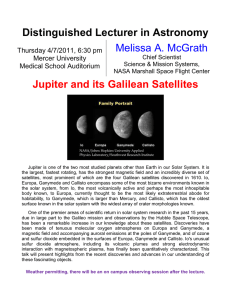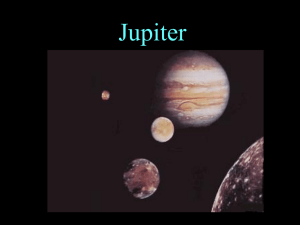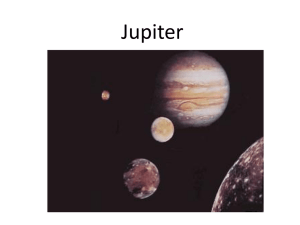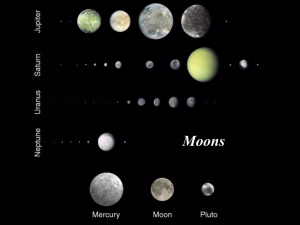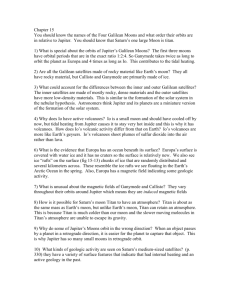– a noble Phoenician descended from Io – abducted Europa Callisto
advertisement
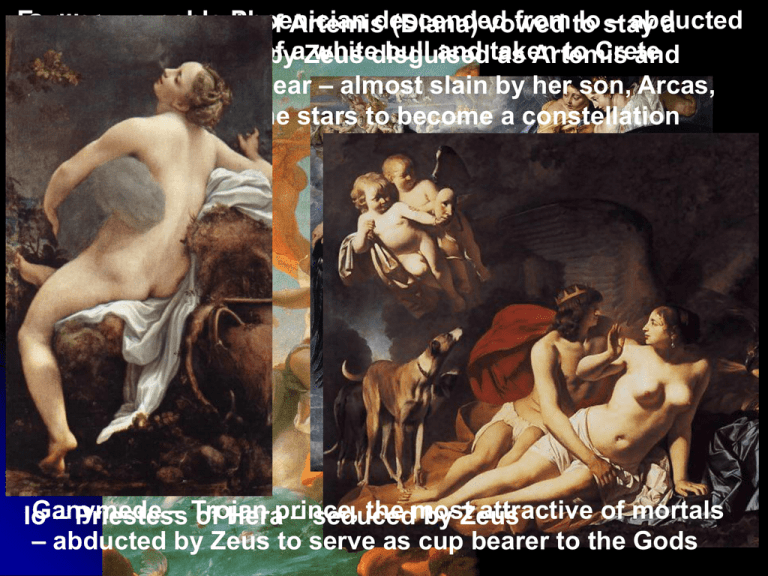
Europa Phoenician from to Io stay – abducted Callisto––aanoble nymph of Artemisdescended (Diana) vowed a by Zeusbut in the form of whitedisguised bull and taken to Crete virgin, seduced byaZeus as Artemis and transformed into a bear – almost slain by her son, Arcas, but placed among the stars to become a constellation Ganymede – Trojan the most attractive of mortals Io – Priestess of Heraprince, – seduced by Zeus – abducted by Zeus to serve as cup bearer to the Gods Jupiter’s Satellites What the Galilean satellites are and how they orbit Jupiter The similarities and differences among the Galilean satellites How the Galilean satellites formed How tidal forces and synchronous orbits affect the Galilean satellites Jupiter’s Satellites Why Io is the most volcanically active world in the solar system How Io interacts with Jupiter’s magnetic field The evidence that Europa may have an ocean beneath its surface The kinds of geologic activity found on Ganymede and Callisto Why most of Jupiter’s moons orbit in the “wrong” direction Orbits of the Galilean Satellites Radius (RJ): Period (days): Io Europa Ganymede Callisto 5.9 9.4 15 26.3 1 2 4 9.43 What is the relationship between the orbital periods of the four Galilean satellites of Jupiter? A. 1:2:4:8— Europa orbits Jupiter twice, Ganymede orbits four times and Callisto orbits eight times during one Io orbit. B. 1:2—Europa takes twice as long to orbit Jupiter as Io, but there is no integer relationship between Callisto and Ganymede with the inner two Galilean moons. C. 1:2:4—Io orbits Jupiter four times and Europa orbits twice during one Ganymede orbit, but there is no integer relationship between Callisto and any of the other Galilean moons. D. The periods appear to be random, with no simple relationship between them. Relative Sizes and Distances from Jupiter Voyager 1—February 1979 Formation of Galilean Satellites Protosun “ice-limit” Proto-Jupiter “ice limit” Formation of Galilean Satellites Voyager Mosaic Image Except for these areas–not seen by Voyager Io Anomaly Discovery— Voyager 1 March 8,1979 What’s this? …an unknown moon behind Io??? No! Galileo composite Image—1996 Side of Io facing Jupiter Galileo Spacecraft 1996 Galileo—November 1997 Tvashtar Plume—New Horizons, Feb 28, 2007 Lava Flow from Tvashtar 2000 Change in Lava Flow from Tvashtar 1999-2000 Eruption from Pillan Patera after several months The source of intense heating in the interior of Jupiter's moon Io, causing continuous and intense volcanic activity, is ______. A.tidal flexing and distortion, caused by Jupiter and the other large moons. B.frictional heating as the solar wind impacts the moon’s surface. C.a black hole in its core swallowing up the matter around it causing Io to slowly contract and heat up. D.heat released as it continues to shrink following its formation, converting gravitational potential energy into heat. Ejection of Sulfur from Io’s Volcanoes Infrared Glow from Active Volcanoes Interior of Io • Thin crust of sulfur and SO2 • Thicker crust and Mantle of Silicates • Dense metallic core Earth-based Infrared Image Io Torus 5 Million Amps of Current flows between Jupiter and Io! Europa—Voyager 1 1979 Galileo Sept 19, 2003—False Color Infrared and Visible Europa’s Ridges and Jumbled Terrain Triple Bands Formed when crust fractures • Ridges separate and darken • Water oozes up and freezes when another fracture occurs Moving Ice Floes in Canadian Arctic Ice Rafts on Europa Interior of Europa The weak and variable magnetic field on Europa measured by the Galileo spacecraft is generated by ______. A.electrical currents in Europa’s subsurface ocean water, induced by Jupiter's intense rotating magnetic field B.electrical currents flowing between Europa and Jupiter C.the motion of molten iron in Europa's core D.electrical currents in the liquid metallic hydrogen in Europa’s core Ganymede—Side Facing Away from Jupiter Grooved Terrain on Ganymede Plate Tectonics on Ganymede? Interior of Ganymede • Ice Crust • Icy Mantle probably includes water and slush zone • Large mantle of silicates • Iron core Callisto—Galileo, May 2001 Only complete global color image taken by Galileo Valhalla Basin • Largest multiringed impact in solar system • Lack of craters <1 km • Covered with dark, dusty material Interior of Callisto • Thick Ice Crust • Water below crust? • Mantle of rock and ice The surfaces of Ganymede and Callisto appear to consist mostly of ______. A.an organic polymer-like goo B.Ice C.rocks and lava D.frozen hydrogen and helium “It's like imagining we'd flown into the solar system the day before and said … let's explain it in ten minutes. There was Callisto, with the highest density of craters of any Galilean satellite, the oldest of the Galilean surfaces, featuring a huge ‘bull's eye’ that is the largest single contiguous feature seen so far in the solar system. There was Ganymede, cratered, but also overrun with fault lines that looked like ‘tire tracks in the desert,’ showing a surface that ‘had laterally slid, faulted and sheared and sheared again, twisted and torn apart.’ There was Io–the most bizarre–the one that scientists thought would be most lunar–like, showing a surface that had apparently been cooked, steamed and fumed out leaving deposits all over the surface like you might see around a fumarole at Yellowstone. It makes it likely that Io is still volcanically active. There was Europa, with huge linear features unlike those of the other three Galileans–Europa the mystery satellite, waiting for the probing eyes of Voyager 2 to survey it in early July. Ed Stone summed it all up, "I think we have had almost a decade's worth of discovery in this two-week period … ." Key Ideas Nature of the Galilean Satellites: The four Galilean satellites orbit Jupiter in the plane of its equator… all in synchronous rotation. The orbital periods of Io, Europa, and Ganymede are in the ratio 1:2:4. The two innermost Galilean satellites, Io and Europa, have roughly the same size and density as our Moon. They are composed principally of rocky material. The two outermost Galilean satellites, Ganymede and Callisto, are roughly the size of Mercury. Lower in density than either the Moon or Mercury, they are made of roughly equal parts ice and rock. The Galilean satellites probably formed in a similar fashion to our solar system but on a smaller scale. Key Ideas Io: Io is covered with a colorful layer of sulfur compounds deposited by frequent explosive eruptions from volcanic vents. These eruptions resemble terrestrial geysers. The energy to heat Io’s interior and produce the satellite’s volcanic activity comes from tidal forces that flex the satellite. This tidal flexing is aided by the 1:2:4 ratio of orbital periods among the inner three Galilean satellites. The Io torus is a ring of electrically charged particles circling Jupiter at the distance of Io’s orbit. Interactions between this ring and Jupiter’s magnetic field produce strong radio emissions. Io may also have a magnetic field of its own. Key Ideas Europa: While composed primarily of rock, Europa is covered with a smooth layer of water ice. The surface has hardly any craters, indicating a geologically active history. Other indications are a worldwide network of long cracks and ice rafts that indicate a subsurface layer of liquid water or soft ice. As for Io, tidal heating is responsible for Europa’s internal heat. An ocean probably lies beneath Europa’s frozen surface. Minerals dissolved in this ocean may explain Europa’s induced magnetic field. Key Ideas Ganymede: Two types of terrain are found on the icy surface of Ganymede: areas of dark, ancient, heavily cratered surface and regions of heavily grooved, lighter-colored, younger terrain. Ganymede is highly differentiated, and probably has a metallic core. It has a surprisingly strong magnetic field and a magnetosphere of its own. While there is at present little tidal heating of Ganymede, it may have been heated in this fashion in the past. An induced magnetic field suggests that it, too, has a layer of liquid water beneath the surface. Key Ideas Callisto: Callisto has a heavily cratered crust of water ice. The surface shows little sign of geologic activity, because there was never any significant tidal heating of Callisto. However, some unknown processes have erased the smallest craters and blanketed the surface with a dark, dusty substance. Magnetic field data seem to suggest that Callisto has a shallow subsurface ocean. Key Ideas Other Satellites: As of 2006, Jupiter has a total of 63 known satellites. In addition to the Galilean satellites, Jupiter has four small inner satellites that lie inside Io’s orbit. Like the Galilean satellites, these orbit in the plane of Jupiter’s equator. The remaining satellites are small and move in much larger orbits that are noticeably inclined to the plane of Jupiter’s equator. Many of these orbit in the direction opposite to Jupiter’s rotation.
